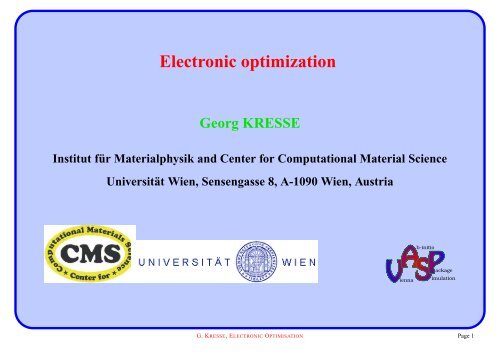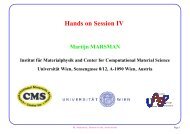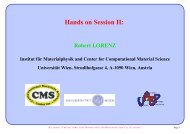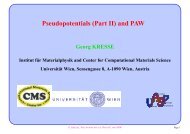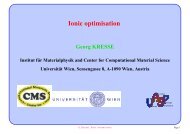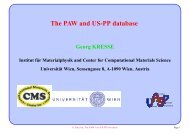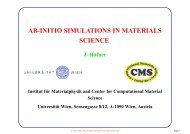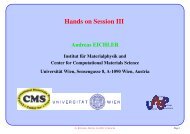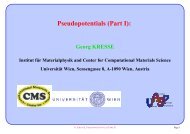Electronic optimization - VASP
Electronic optimization - VASP
Electronic optimization - VASP
Create successful ePaper yourself
Turn your PDF publications into a flip-book with our unique Google optimized e-Paper software.
<strong>Electronic</strong> <strong>optimization</strong><br />
Georg KRESSE<br />
Institut für Materialphysik and Center for Computational Material Science<br />
Universität Wien, Sensengasse 8, A-1090 Wien, Austria<br />
ienna<br />
b-initio<br />
ackage<br />
imulation<br />
G. KRESSE, ELECTRONIC OPTIMISATION Page 1
Overview<br />
Determination of the electronic grounstate<br />
– general strategies<br />
– strategy adopted in <strong>VASP</strong><br />
iterative matrix diagonalization and mixing<br />
– how to overcome slow convergence<br />
molecular dynamics<br />
the algorithms are particularly well suited for molecular dynamics<br />
G. KRESSE, ELECTRONIC OPTIMISATION Page 2
density and kinetic energy:<br />
Density functional theory according to Kohn-Sham<br />
sum of one electron charge densities and kinetic energies<br />
©<br />
�<br />
¯h 2<br />
2<br />
2me<br />
ρ tot¡ r¢£<br />
Ne¤ 2<br />
¥<br />
∑<br />
n<br />
1<br />
2<br />
∑<br />
Ne¤ 2<br />
n<br />
ψn¡ r¢��<br />
kinetic energy<br />
��<br />
¥<br />
1¦<br />
¦<br />
ψn¡ r¢<br />
ρ ion¡ r¢¨<br />
2§<br />
∇ 2 ψn¡ r¢ d 3 r<br />
�<br />
§<br />
�<br />
1<br />
2<br />
Ne number of electrons<br />
ρ tot¡ r¢ ρ tot¡ r<br />
¦<br />
r© r�<br />
¦<br />
electrost. energy<br />
KS-functional has a (the) minimum at the electronic groundstate<br />
��<br />
�<br />
¢<br />
d 3 rd 3 r<br />
�<br />
�<br />
�<br />
§<br />
Exc� ρ¡ r¢<br />
LDA/GGA<br />
G. KRESSE, ELECTRONIC OPTIMISATION Page 3<br />
��<br />
�<br />
�
Numerical determination of the Kohn-Sham groundstate<br />
direct minimization of the DFT functional (Car-Parrinello, modern)<br />
start with a set of wavefunctions � ψn� r�<br />
value of the functional (iteration)<br />
Gradient: Fn¡ r¢ £<br />
©<br />
¯h 2<br />
2me<br />
n� �<br />
� 1���<br />
� Ne� 2� (random numbers) and minimizes the<br />
∇ 2§V eff¡ r¨<br />
iteration – self consistency (old fashioned)<br />
� ψn¡ r�<br />
�¢<br />
¢<br />
©<br />
εn ψn¡ r¢<br />
start with a trial density ρ, set up the Schrödinger equation, and solve the Schrödinger equation<br />
to obtain wavefunctions ψn� r�<br />
©<br />
¯h 2<br />
2me<br />
∇ 2§V eff¡ r¨<br />
as a result one obtains a new charge density ρ� r��<br />
equation �<br />
iteration<br />
ρ¡<br />
�<br />
¢ r�<br />
�¢<br />
ψn¡ r¢£<br />
εnψn¡ r¢<br />
∑n� ψn� r�<br />
� 2 and a new Schrödinger<br />
n £<br />
1¨��<br />
�<br />
�<br />
¨ Ne� 2<br />
G. KRESSE, ELECTRONIC OPTIMISATION Page 4
L<br />
��<br />
� ��<br />
�<br />
��<br />
� ��<br />
� �<br />
� ��<br />
� �<br />
� � ��<br />
� �<br />
� � ��<br />
� �<br />
��<br />
� ��<br />
� �<br />
��<br />
� ��<br />
� �<br />
� ��<br />
� �<br />
��<br />
� ��<br />
� �<br />
��<br />
� ��<br />
� �<br />
��<br />
� ��<br />
� �<br />
� ��<br />
� �<br />
��<br />
� ��<br />
� �<br />
� ��<br />
� �<br />
� ��<br />
� �<br />
� ��<br />
� �<br />
� � ��<br />
� �<br />
� ��<br />
� �<br />
� � � �<br />
��<br />
�<br />
� � � �<br />
��<br />
�<br />
� ��<br />
� �<br />
��<br />
� ��<br />
�<br />
� ��<br />
� �<br />
� � � �<br />
��<br />
�<br />
��<br />
� ��<br />
�<br />
� ��<br />
� �<br />
� � � �<br />
��<br />
�<br />
� ��<br />
� �<br />
� � � �<br />
��<br />
�<br />
� ��<br />
� �<br />
� � � �<br />
��<br />
�<br />
n=1<br />
��<br />
��<br />
��<br />
��<br />
����<br />
� ��<br />
� �<br />
n=8<br />
log 10 E-E 0<br />
log 10 |F-F 0 |<br />
0<br />
-2<br />
-4<br />
-6<br />
-8<br />
1<br />
0<br />
-1<br />
-2<br />
-3<br />
-4<br />
disordered diamond, insulator<br />
n=1,2,4,8<br />
direct<br />
Car−Parrinello<br />
self.consistent<br />
0 5 10 15 20<br />
iteration<br />
energy<br />
log 10 E-E 0<br />
log 10 |F-F 0 |<br />
forces<br />
G. Kresse and J. Furthmüller, Phys. Rev. B 54, 11169 (1996).<br />
2<br />
0<br />
-2<br />
-4<br />
-6<br />
-8<br />
1<br />
0<br />
-1<br />
-2<br />
-3<br />
-4<br />
disordered fcc Fe, metal<br />
n=1<br />
n=8<br />
n=4<br />
direct<br />
Car−Parrinello<br />
n=1<br />
self.consistent<br />
0 10 20 30 40<br />
iteration<br />
G. KRESSE, ELECTRONIC OPTIMISATION Page 5
Direct minimization (not supported by vasp.4.5)<br />
preconditioned conjugate gradient algorithm was applied<br />
Gradient: Fn¡ r¢ £<br />
the main troubles are<br />
©<br />
¯h 2<br />
2me<br />
– to keep the set of wavefunctions � ψn¡ r¢<br />
– “sub-space” rotation<br />
�<br />
�<br />
�<br />
∇ 2§V eff¡ r¨<br />
¦<br />
n £<br />
� 1¨�<br />
� ψn¡ r�<br />
�¢<br />
¢<br />
©<br />
εn ψn¡ r¢<br />
¨ Ne� 2� orthogonal<br />
at the end one aims to have a set of wavefunction n £<br />
ψn¡ r¢<br />
�<br />
diagonalize the Hamiltonian<br />
ψn ¦ �<br />
H¦<br />
ψm�£<br />
δnm¯εn<br />
¦<br />
1¨�<br />
�<br />
¨ Nbands� that<br />
for metals, this condition is difficult to achieve with direct algorithms<br />
in metals, actually this optimisation subproblem leads to a linear slowdown<br />
with the longest dimension of the (super)cell<br />
G. KRESSE, ELECTRONIC OPTIMISATION Page 6
� �<br />
Selfconsistency Scheme<br />
trial-charge ρin and trial-wavevectors ψn<br />
set up Hamiltonian H¡ ρin¢<br />
�<br />
iterative refinements of wavefunctions � ψn�<br />
new charge density ρout £<br />
�<br />
�<br />
∑n fn<br />
¦<br />
ψn¡ r¢<br />
refinement of density ρout new ρin<br />
ρin¨<br />
�<br />
no<br />
�<br />
�<br />
��<br />
�<br />
�<br />
�<br />
�<br />
�<br />
�<br />
�<br />
�<br />
�<br />
ΔE Ebreak �<br />
�<br />
�<br />
�<br />
calculate forces, update ions<br />
�<br />
�<br />
�<br />
�<br />
�<br />
�<br />
��<br />
�<br />
¦<br />
2<br />
� �<br />
�<br />
�<br />
�<br />
two subproblems<br />
<strong>optimization</strong> of � ψn� and ρin<br />
refinement of density:<br />
DIIS algorithm<br />
P. Pulay, Chem. Phys. Lett. 73,<br />
393 (1980).<br />
refinement of wavefunctions:<br />
DIIS or Davidson algorithm<br />
G. KRESSE, ELECTRONIC OPTIMISATION Page 7
ALGO flag<br />
ALGO determines how the wavefunctions are optimized<br />
all algorithms are fully parallel for any data distribution scheme<br />
– ALGO= Normal (default): blocked Davidson algorithm<br />
– ALGO= Very Fast: DIIS algorithm<br />
– ALGO= Fast: 5 initial steps blocked Davidson, afterwards DIIS algorithm<br />
after ions are moved: 1 Davidson step, afterwards again DIIS<br />
RMM-DIIS is 1.5 to 2 times faster, but Davidson is more stable<br />
ALGO= Fast is a very reasonable compromise, and should be specified for system<br />
with more than 10-20 atoms<br />
generally the user can not influence the behavior of these algorithms (delicately<br />
optimized black box routines)<br />
G. KRESSE, ELECTRONIC OPTIMISATION Page 8
OSZICAR and OUTCAR files<br />
POSCAR, INCAR and KPOINTS ok, starting setup<br />
WARNING: wrap around errors must be expected<br />
prediction of wavefunctions initialized<br />
entering main loop<br />
N E dE d eps ncg rms rms(c)<br />
DAV: 1 0.483949E+03 0.48395E+03 -0.27256E+04 96 0.166E+03<br />
DAV: 2 0.183581E+01 -0.48211E+03 -0.47364E+03 96 0.375E+02<br />
DAV: 3 -0.340781E+02 -0.35914E+02 -0.35238E+02 96 0.129E+02<br />
DAV: 4 -0.346106E+02 -0.53249E+00 -0.53100E+00 112 0.158E+01<br />
DAV: 5 -0.346158E+02 -0.52250E-02 -0.52249E-02 96 0.121E+00 0.198E+01<br />
RMM: 6 -0.286642E+02 0.59517E+01 -0.50136E+01 96 0.584E+01 0.450E+00<br />
RMM: 7 -0.277225E+02 0.94166E+00 -0.47253E+00 96 0.192E+01 0.432E+00<br />
initial charge corresponds to the charge of isolated overlapping atoms (POTCAR)<br />
DAV: blocked Davidson algorithm RMM: RMM-DIIS was used<br />
ALGO=F: 5 initial steps blocked Davidson, than RMM-DIIS<br />
4 steps charge fixed, than charge is updated (rms(c) column)<br />
G. KRESSE, ELECTRONIC OPTIMISATION Page 9
N iteration count<br />
E total energy<br />
dE change of total energy<br />
OSZICAR file<br />
d eps change of the eigenvalues (fixed potential)<br />
ncg number of optimisation steps Hψ<br />
rms total initial residual vector ∑nk wk fnk¡ H©<br />
rms(c) charge density residual vector<br />
εnk¢ ψnk<br />
G. KRESSE, ELECTRONIC OPTIMISATION Page 10
initial steps (delay no charge update)<br />
OUTCAR file<br />
cpu time wall clock time<br />
POTLOK: VPU time 0.04: CPU time 0.04 local potential<br />
SETDIJ: VPU time 0.08: CPU time 0.08 set PAW strength coefficients<br />
EDDAV : VPU time 0.94: CPU time 0.94 blocked Davidson<br />
DOS : VPU time 0.00: CPU time 0.00 new density of states<br />
----------------------------------------<br />
LOOP: VPU time 1.06: CPU time 1.06<br />
charge update:<br />
cpu time wall clock time<br />
POTLOK: VPU time 0.04: CPU time 0.04 new local potential<br />
SETDIJ: VPU time 0.09: CPU time 0.09 set PAW strength coefficients<br />
EDDIAG: VPU time 0.14: CPU time 0.14 sub-space rotation<br />
RMM-DIIS: VPU time 0.77: CPU time 0.77 RMM-DIIS step (wavefunc.)<br />
ORTHCH: VPU time 0.01: CPU time 0.02 orthogonalisation<br />
DOS : VPU time -0.01: CPU time 0.00 new density of states<br />
CHARGE: VPU time 0.07: CPU time 0.07 new charge<br />
MIXING: VPU time 0.01: CPU time 0.01 mixing of charge<br />
G. KRESSE, ELECTRONIC OPTIMISATION Page 11
What have all iterative matrix diagonalisation schemes in common ?<br />
one usually starts with a set of trial vectors (wavefunctions) representing the filled<br />
states and a few empty one electron states<br />
ψn �<br />
¦<br />
n £<br />
� 1¨��<br />
¨ Nbands�<br />
these are initialized using a random number generator<br />
then the wavefunctions are improved by adding to each a certain amount of the<br />
residual vector<br />
¦<br />
the residual vector is defined as<br />
R¡ ψn¢<br />
£ �<br />
H©<br />
¡<br />
εappS¢<br />
¦<br />
ψn�<br />
εapp £<br />
adding a small amount of the residual vector<br />
ψn�<br />
ψn§<br />
ψn ¦ �<br />
H¦<br />
λR¡ ψn¢<br />
ψn�<br />
is in the spirit of the steepest descent approach (usually termed “Jacobi relaxation”)<br />
G. KRESSE, ELECTRONIC OPTIMISATION Page 12
Iterative matrix diagonalization based on the DIIS algorithm<br />
for our case we need a rather specialized eigenvalue solver<br />
– it should be capable of doing only little work<br />
– efficiency and parallelization are important issues<br />
two step procedure<br />
– start with a set of trial vectors (wavefunctions) representing the electrons<br />
ψn �<br />
¦<br />
n £<br />
1¨��<br />
�<br />
¨ Nbands� (initialized with random numbers)<br />
– apply Raighly Ritz <strong>optimization</strong> in the space spanned by all bands (“sub-space”<br />
rotation)<br />
transform: � ψn<br />
¦<br />
n £<br />
1¨�<br />
�<br />
¨ Nbands� so that<br />
ψn ¦ �<br />
H¦<br />
ψm�£<br />
– then optimize each vector individually � ψn<br />
¦<br />
n £<br />
δnm¯εn<br />
� 1¨�<br />
¨ Nbands� two or three times<br />
G. KRESSE, ELECTRONIC OPTIMISATION Page 13
“In space” <strong>optimization</strong> EDDIAG<br />
a set of vectors, that represent the valence electrons � ψn<br />
¦<br />
n £<br />
1¨��<br />
�<br />
¨ Nbands�<br />
Raighly Ritz <strong>optimization</strong> in the space spanned by these vectors (subspace)<br />
search for the unitary matrix Ū such that the wavefunctions ψ�<br />
n<br />
fulfill � ψ�<br />
¦<br />
n<br />
H¦<br />
m�£<br />
ψ�<br />
εmδnm<br />
ψ�<br />
n ∑Ūmnψm £<br />
m<br />
this requires the calculation of the subspace matrix ¯H<br />
ψn ¦ �<br />
H¦<br />
ψm�£<br />
and it’s diagonalisation<br />
¯Hmn ¡<br />
ψn ¦ �<br />
¦<br />
S<br />
ψm�£<br />
δmn always holds¢<br />
the setup of the matrix scales like N 2 bands NFFT (worst scaling part of <strong>VASP</strong>)<br />
in the parallel version, communication is required, but modest<br />
worse is the fact that the diagonalisation of ¯Hmn is not done in parallel<br />
G. KRESSE, ELECTRONIC OPTIMISATION Page 14
Iterative matrix diagonalization based on the DIIS algorithm<br />
“out of space <strong>optimization</strong>” EDDRMM<br />
– minimize norm of residual vector using the DIIS method<br />
¦<br />
R¡ ψn¢<br />
£ �<br />
H©<br />
¡<br />
εappS¢<br />
¦<br />
ψn�<br />
R¡<br />
�<br />
ψn¢<br />
¦<br />
R¡ ψn¢ ��<br />
minimal<br />
– each vector is optimized individually (without regard to any other vector)<br />
– easy to implement on parallel computers since each processor handles a subset of<br />
the vectors (no communication required, NPAR=number of proc.)<br />
scaling is propotional to NbandsNFFT with a large prefactor<br />
dominates the compute time for medium to large problems<br />
orthogonalization of wavefunctions ORTHCH<br />
G. KRESSE, ELECTRONIC OPTIMISATION Page 15
Problem of the DIIS algorithm<br />
eigenstates can be missed for large systems<br />
and there is no clear way to tell when this happens<br />
– in the “best” case no convergence<br />
– but convergence might also slows down after reaching a precision of 10<br />
– in the worst case, you might not notice anything<br />
�<br />
2 or 10<br />
in these cases, switch to blocked Davidson (manual contains a number of tricks how you<br />
might be able to use the DIIS algorithm even when it initially fails)<br />
things are not that bad<br />
if the Davidson algorithm is used for the first steps, there is practically no danger of<br />
missing eigenstates<br />
G. KRESSE, ELECTRONIC OPTIMISATION Page 16<br />
�<br />
3
<strong>VASP</strong>.4.5: new blocked Davidson algorithm<br />
combines “in space” and “out of space” <strong>optimization</strong><br />
selects a subset of all bands � ψn<br />
¦<br />
n £<br />
1¨�<br />
�<br />
¨ Nbands��<br />
ψk �<br />
¦<br />
k £<br />
n1¨��<br />
�<br />
¨ n2�<br />
– optimize this subset by adding the orthogonalized residual vector to the presently<br />
considered subspace<br />
ψk¨<br />
�<br />
H©<br />
¡<br />
εappS¢ ψk<br />
¦<br />
k £<br />
n1¨��<br />
¨ n2�<br />
– apply Raighly Ritz <strong>optimization</strong> in the space spanned by these vectors<br />
(“sub-space” rotation in a 2(n2-n1+1) dim. space)<br />
– add additional residuals calculated from the yet optimized bands (“sub-space”<br />
rotation in a 3(n2-n1+1) dim. space)<br />
approximately a factor of 1.5-2 slower than RMM-DIIS, but always stable<br />
available in parallel for any data distribution<br />
G. KRESSE, ELECTRONIC OPTIMISATION Page 17
charge density mixing (RMM-DIIS)<br />
<strong>VASP</strong> aims at the minimization of the norm of residual vector<br />
with ρout¡ �<br />
r¢£<br />
R� ρin�£<br />
∑occupied wk fnkψnk¡ �<br />
ρout� ρin�©<br />
r¢ 2<br />
ρin ¦<br />
R� ρin�¦<br />
�<br />
min<br />
DIIS algorithm is used for the <strong>optimization</strong> of the norm of the residual vector<br />
linearization of R� ρin� around ρsc (linear response theory)<br />
R� ρ�£<br />
with the charge dielectric function J<br />
leads to<br />
R� ρin�£<br />
J £<br />
©<br />
1©<br />
ρout� ρin�©<br />
χ U<br />
�<br />
��<br />
ρin £<br />
J¡ ρ© ρsc¢¨<br />
4πe 2<br />
q 2<br />
�<br />
¨<br />
J¡ ρin ©<br />
ρsc¢<br />
G. KRESSE, ELECTRONIC OPTIMISATION Page 18
Divergence of the dielectric function<br />
eigenvalue spectrum of J determines convergence<br />
J £<br />
1©<br />
χ U<br />
�<br />
��<br />
4πe 2<br />
q 2<br />
“broader” eigenvalue spectrum slower convergence �<br />
for insulators and semi-conductors the width of the eigenvalue spectrum is constant<br />
and system size independent !<br />
for metals the eigenvalue spectrum diverges, its width is proportional to the square of<br />
the longest dimension of the cell:<br />
– short wavelength limit 1 (no screening)<br />
J�<br />
– long wavelength limit J<br />
�<br />
�<br />
1� q 2 ∝ L 2 (metallic screening)<br />
complete screening in metals causes slow convergence to the groundstate (charge<br />
sloshing)<br />
¨<br />
G. KRESSE, ELECTRONIC OPTIMISATION Page 19
�<br />
<strong>VASP</strong> uses a model dielectric function<br />
which is a good initial approximation<br />
for most systems<br />
J<br />
�<br />
1<br />
G 1 q £<br />
q 2§�<br />
q 2�<br />
max¡<br />
defaults:<br />
AMIX=0.4 ; AMIN=0.1 ;<br />
BMIX=1.0<br />
��<br />
<strong>VASP</strong> charge density mixer<br />
�<br />
��<br />
¨�<br />
�<br />
��<br />
�<br />
¢<br />
J<br />
0.4<br />
0.3<br />
0.2<br />
0.1<br />
this is combined with a convergence accelerator<br />
AMIN<br />
0<br />
0 1 2 3 4<br />
G (1/A 2 )<br />
AMIX<br />
the initial guess for the dielectric matrix is improved using information accumulated<br />
in each electronic (mixing) step<br />
direct inversion in the iterative subspace (DIIS)<br />
G. KRESSE, ELECTRONIC OPTIMISATION Page 20
How can you tune <strong>VASP</strong> to achieve faster convergence<br />
try linear mixing (AMIX=0.1-0.2, BMIX=0.0001)<br />
�<br />
J<br />
�<br />
1<br />
G 1 q A £<br />
<strong>VASP</strong> also gives information on how good the initial mixing parameters are<br />
allow <strong>VASP</strong> to run until selfconsistency is achieved and search for the last occurrence<br />
of<br />
eigenvalues of (default mixing * dielectric matrix)<br />
average eigenvalue GAMMA= 2.200<br />
– for linear mixing (e.g. AMIX=0.1 ; BMIX=0.0001) the optimal AMIX is given by<br />
the present AMIX�<br />
GAMMA<br />
– Kerker like mixing (model dielectric matrix):<br />
�<br />
�<br />
GAMMA larger decrease BMIX<br />
1�<br />
GAMMA smaller increase BMIX<br />
1�<br />
G. KRESSE, ELECTRONIC OPTIMISATION Page 21
use Davidson (ALGO=N)<br />
use this setting<br />
What to do when electronic convergence fails<br />
converges<br />
fails to converge<br />
converges<br />
converges<br />
ICHARG=12 (no charge update)<br />
converges<br />
play with mixing parameters<br />
ICHARG=2<br />
AMIX=0.1 ; BMIX=0.01<br />
fails to converge<br />
increase BMIX<br />
BMIX=3.0 ; AMIN=0.01<br />
fails to converge<br />
fails to converge<br />
bug report<br />
after positions have been checked<br />
G. KRESSE, ELECTRONIC OPTIMISATION Page 22
CP approach<br />
elegant<br />
simple to implement<br />
ab initio Molecular dynamics<br />
problematic for metals, since<br />
electrons must decouple from ionic<br />
degrees of freedom<br />
not the case for metals<br />
problematic for metals<br />
large memory requirements<br />
small timestep<br />
large timestep<br />
damped second order<br />
(Tassone, Mauri, Car)<br />
conjugate gradient<br />
(Arias, Payne, Joannopoulos)<br />
RMM−DIIS<br />
(Hutter, Lüthi, Parrinello)<br />
exact KS−groundstate<br />
direct minimization selfconsistency cycle<br />
very stable<br />
efficient for insulators<br />
and metals<br />
G. KRESSE, ELECTRONIC OPTIMISATION Page 23
Selfconsistency cycle is very well suited for MDs<br />
MD on the Born Oppenheimer surface (exact KS-groundstate)<br />
selfconsistency cycle determines the dielectric matrix<br />
first time step is rather expensive<br />
but since the dielectric matrix changes only little when ions are moved, the method<br />
becomes very fast in successive steps<br />
wavefunctions and charges etc. are “forward” extrapolated between time-steps<br />
all this makes an extremely efficient scheme that is competitive with the so called<br />
“Car-Parrinello” scheme for insulators<br />
for metals, our scheme is generally much more robust and efficient than the<br />
Car-Parrinello scheme<br />
to select this feature in <strong>VASP</strong>, set MAXMIX in the INCAR file<br />
G. KRESSE, ELECTRONIC OPTIMISATION Page 24
Using MAXMIX<br />
usually <strong>VASP</strong> resets the dielectric matrix to it’s default after moving the ions<br />
but if the ions move only a little bit one can bypass this reset<br />
– definitely a good option for molecular dynamics<br />
– damped molecular dynamics (optimisation)<br />
– works also well during relaxations, if the forces are not large (�0.5 eV/ ˚A)<br />
you need to specify MAXMIX in the INCAR file<br />
set MAXMIX to roughly three times the number of iterations in the first ionic step<br />
the resulting speedups can be substantial (a factor 2 to 3 less electronic steps for each<br />
ionic step)<br />
G. KRESSE, ELECTRONIC OPTIMISATION Page 25
a simple INCAR file<br />
Using Molecular dynamics<br />
ENMAX = 250 ; LREAL = A # electronic degrees<br />
ALGO = V # very fast algorithm<br />
MAXMIX = 80 # mixing<br />
IBRION = 0 # MD<br />
NSW = 1000 # number ofMD steps<br />
POTIM = 3.0 # time step<br />
TEBEG = 1500 ; TEEND = 500 # target temperature 1500-500 K<br />
SMASS = -1 ; NBLOCK = 50 # scale velocities every 50 steps<br />
SMASS = 2 # use a Nose Hoover thermostat<br />
SMASS = -3 # micro canonical<br />
G. KRESSE, ELECTRONIC OPTIMISATION Page 26
Using Molecular dynamics<br />
timestep POTIM, depends on the vibrational frequencies and the required energy<br />
conservation<br />
as a rule of thumb: increase POTIM until 3 electronic minisation steps are required per<br />
timestep<br />
another rule of thumb:<br />
H<br />
Li-F<br />
0.5 fs<br />
1 fs<br />
increase by 1 fs for each row<br />
SMASS controls the MD simulation<br />
– SMASS=-3 micro canonical ensemble<br />
– for equilibration and simulated annealing SMASS = -1 ; NBLOCK = 50-100<br />
microcanonical MD, and every NBLOCK steps the kinetic energy is scaled to<br />
meet the requied temperature criterion<br />
– for positive values a Nose Hoover thermostat is introduced<br />
G. KRESSE, ELECTRONIC OPTIMISATION Page 27


